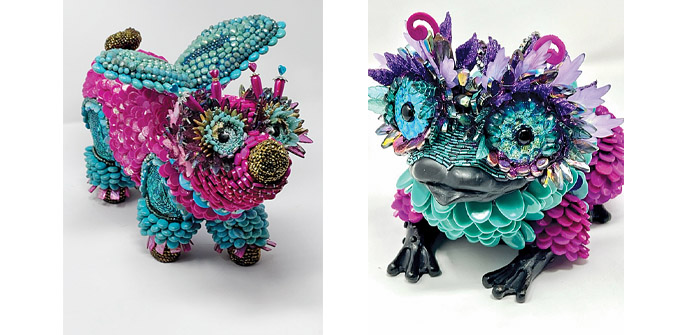(Multimedia mosaic art by Joanie Callen)
The mosaic art pieces made by Joanie Callen are a feast for the eyes. They sparkle with crystal beads, flash with iridescent dichroic glass, shimmer with gold and silver glass feathers, and bristle with pointy dagger beads. Her shapes are also distinctive: Animal shapes like birds and frogs are three-dimensional instead of flat surfaces. Callen is a showcase artist in October at Red Chair Gallery.
In the past, Callen created larger pieces like horseheads and wall masks but now she is concentrating on smaller works. “I really enjoy doing animals,” she says. “It’s fun and fulfilling to create these goofy things,” she laughs, adding that she is often “blown away” by how differently a piece turns out from her original concept.
Although her work looks whimsical and spontaneous, Callen spends many hours planning each piece and fashioning 80% of the materials she uses. First, she chooses a figurine for the base, such as a fish or an owl that she found at a garden or thrift store. Then she comes up with a color scheme for the object and draws patterns in 3D for the surface.
While Callen uses some imported beads and shells in her work, she began making her own feather- and leaf-shaped pieces out of resin during the COVID-19 pandemic, when materials became hard to source. This results in more work for her but she is able to imbue her pieces with color and glitter to her taste. She started making these hard-to-get pieces in baking molds but soon learned to make her own molds. She fills them with resin, glitter and dye and then waits 24 hours for them to dry. She also cuts thousands of shapes out of glass sheets and fashions others from clay, then fires them in a kiln.
After fabricating all this material, she can finally start affixing it to the figurine. Each piece takes two to four months to complete and she usually works on a few pieces at a time. She estimates that she puts in between four and eight hours a day six days a week.
Callen was not always an artist. She had a long career as a budget analyst for the State of California in Sacramento. She fell in love with the work of a mosaic artist at an art fair. She took a course in Ravenna, Italy on ancient Byzantine Era mosaic techniques; then took more classes in California where she learned to make mosaics more colorful and include different materials such as beads, chain and mirror glass. Later, she learned how to apply mosaics to 3D pieces, like animal figures, using a base of epoxy resin.
After retirement, Callen moved to Bend where she has continued to develop her own very personal style of mosaic art. But now the long hours she puts in are immensely more fulfilling than the work she used to do.

